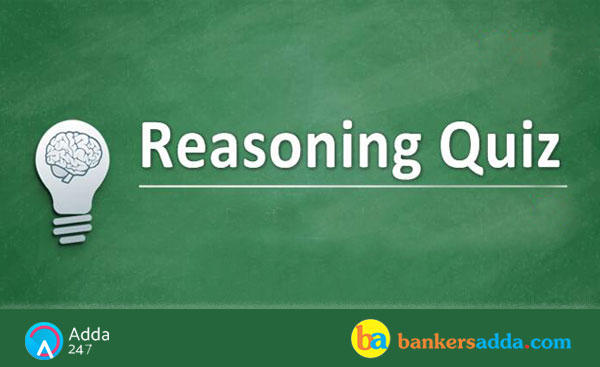Dear Aspirants,
Reasoning Ability is an onerous section. With the increasing complexity of questions, it becomes hard for one to give it the cold shoulder. The only way to make the grade in this particular section in the forthcoming banking exams is to practice continuously with all your heart and soul. And, to let you practice with the best of the latest pattern questions, here is the Adda247 Night Reasoning Quiz based on the exact same pattern of questions that are being asked in the exams.
Directions (1-5): Study the following information carefully and answer the questions given below:
Twelve people are sitting in two parallel rows containing six people each, in such a way that there is an equal distance between adjacent persons. In row–1 A, B, C, D, E and F are seated and all of them are facing South. In row-2 P, Q, R, S, T and V are seated and all of them are facing north. Therefore, in the given seating arrangement each member seated in a row faces another member of the other row.
P sits third to the left of T. Neither P nor T sits at an extreme end of the line. A sits second to the right of E. Neither A nor E faces T or P. A does not sit at an extreme end. R does not face A and R does not sit at an extreme end of the line. Only one person sits between F and C. Neither F nor C faces T. C does not sit at the extreme end. Only one person sits between V and Q. F is not an immediate neighbour of B . A does not face V.
Q1. How many people sit right of V?
(a) One
(b) Two
(c) Three
(d) No one
(e) Five
Q2. V is related to B in the same way as Q is related to C. To which of the following is P related to, following the same pattern?
(a) F
(b) A
(c) D
(d) E
(e) None of these
Q3. Which of the following is true regarding V?
(a) V faces A
(b) T is not an immediate neighbour of V.
(c) C faces the one who is second to left of V
(d) V sits at one of the extreme ends of the line
(e) R sits third to the right of V
Q4. Who among the following sit at extreme ends of the rows?
(a) D, F
(b) V, S
(c) Q, S
(d) B, D
(e) None of these
Q5. Who among the following faces B?
(a) V
(b) S
(c) Q
(d) R
(e) T
Directions (6-10): Study the following information to answer the given questions :
In a certain code language,
“ge ji zo” means “ ‘had find cream’,
“ji so pit” means ‘realise here cream’ and
“ge ze pat ze” means ‘very very find book’.
Q6.Which of the following is the code of ‘here’ ?
(a) ji
(b) zo
(c) pit
(d) Can’t be determined
(e) None of these
Q7.‘ji ze ’ may represent ?
(a) very find
(b) you had
(c) had realise
(d) very cream
(e) here had
Q8.‘ find book’, can be coded as ?
(a) zo ge
(b) pat ge
(c) zo pit
(d) Can’t be determined
(e) None of these
Q9.Which of the following is the code of ‘very’ ?
(a) ge
(b) pat
(c) ze
(d) can’t be determined
(e) None of these
Q10. Which of the following is the code of ‘had’ ?
(a) ge
(b) ji
(c) zo
(d) Can’t be determined
(e) None of these
Directions (11-12): Read the following information carefully and answer the questions given below.
In a study of the five brands namely C, P, A, G and B of cloths were tested and ranked against expensiveness. The following results were obtained.
P and G were equally expensive. B was the least expensive brand among them.C was less expensive than P.G was less expensive than A.The expensiveness of A was more than that of P.
Q11. If the above statements are true, which of the following must also be true?
(a) A was the most expensive among them
(b) C was more expensive than A
(c) G was somewhere in the middle when they were set in descending order in terms of expensiveness.
(d) C was the most expensive among them
(e) None of the above
Q12. If a sixth brand F is tested and found to be more expensive that A, then which of the following must be true if the findings of the study are correct?
(a) At most three of the six brands are less expensive than F
(b) F is the most expensive
(c) P is more expensive than F
(d) F is less expensive than C
(e) None of the above
Q13. A + B means A is son of B; A – B means A is wife of B; A × B means A is brother of B; A ÷ B means A is mother of B and A = B means A is the sister of B then what does P + R – Q means?
(a) Q is the brother of P
(b) Q is the son of P
(c) Q is the uncle of P
(d) Q is the father of P
(e) None of these
Q14. Manishi walks 20 km north and then she turns her right and walks 30 km. Then she turns right again and walks 35km and then she turns left and walks 15 km. Then she again turns left and walks 15 km. In which direction and how many km away is she from his original position?
(a) 15 km, West
(b) 30 km, East
(c) 30 km, West
(d) 55 km, East
(e) 45 km, East
Q15. Vijay starts walking towards East. After walking 35 m, he turns to his right and walks another 40 m. He then turns right again and walks another 35 m. Finally, he turns right and walks 20 m. In which direction and how far is he from the starting point?
(a) 20 m, North
(b) 35 m, South
(c) 35 m, North
(d) 20 m, South



 Reasoning Quiz For Bank Foundation 2024 ...
Reasoning Quiz For Bank Foundation 2024 ...
 Reasoning Quiz For Bank Foundation 2024 ...
Reasoning Quiz For Bank Foundation 2024 ...



